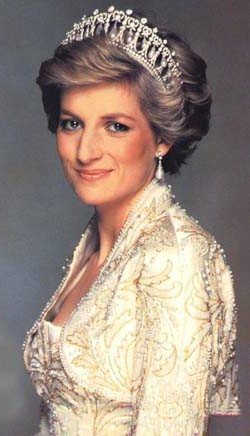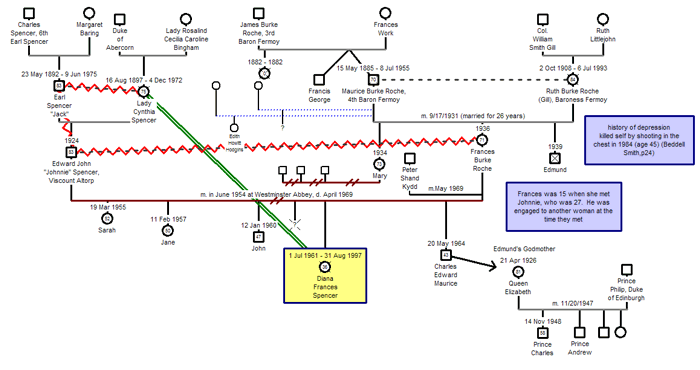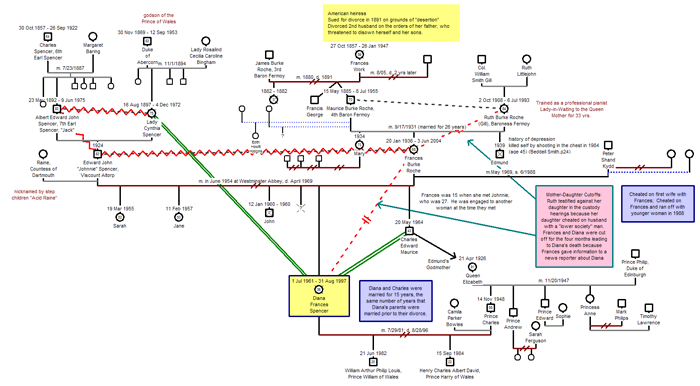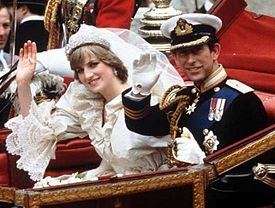The Role of Gender in the Family of Diana, Princess of Wales
By Laura M. Benton, from the Multicultural Family Institute.
The example of Princess Diana, while particular to her family's situation, reflects common family gender problems, which
exist the world over. Using a genogram to display her family history, it becomes clear that Diana belonged to an upper-class British family whose gender roles, while typical of that
period, likely influenced family relationships in multiple generations.
 Both sets of Diana's grandparents had relationships which exemplified male dominance and female subservience. Her maternal grandfather, Lord (Maurice) Fermoy, was a womanizer and had
multiple affairs, producing at least two illegitimate children. His wife, Lady (Ruth) Fermoy, knew full well that as a woman, her only access to power or prestige would be through
a man; she had to marry a gentleman whose societal position and fortune were secure. She was first courted by Lord Fermoy's twin brother, Francis George, but in the interest of forging
a higher social status, she changed her focus to Maurice who was the elder brother, and thus the brother with a title. (Francis George never married thereafter.) Maurice and Ruth Fermoy
married and had two daughters, Mary and Frances, and a son, Edmund.
Both sets of Diana's grandparents had relationships which exemplified male dominance and female subservience. Her maternal grandfather, Lord (Maurice) Fermoy, was a womanizer and had
multiple affairs, producing at least two illegitimate children. His wife, Lady (Ruth) Fermoy, knew full well that as a woman, her only access to power or prestige would be through
a man; she had to marry a gentleman whose societal position and fortune were secure. She was first courted by Lord Fermoy's twin brother, Francis George, but in the interest of forging
a higher social status, she changed her focus to Maurice who was the elder brother, and thus the brother with a title. (Francis George never married thereafter.) Maurice and Ruth Fermoy
married and had two daughters, Mary and Frances, and a son, Edmund.
Since Ruth understood the value of marrying well, and was eager to further secure her family's position in the British social hierarchy, it was said that when it came to her daughters,
"nobody was more tenacious in the social marriage market than Ruth Fermoy... Realising that the less attractive older daughter Mary... would be a tougher sell, she fixed her hopes on the
prospects of Frances and delayed Mary's coming-out dance until she could do a double whammy with the added value of both" (Brown 31). Lady Fermoy set her sights on the eligible and
desirable Viscount Althorp ("Johnnie") Spencer, a man who was to inherit the title of Eighth Earl Spencer upon the death of his father. He was handsome, educated and considered quite
a catch, so when Lady Fermoy encountered him at a social event in the spring of 1952, she was eager to connect him with her most desirable daughter, Frances, though she was only fifteen
years old at the time.
"Lady Cynthia, who was generous and compassionate, but was overpowered by her dominant husband"
Johnnie's father, the Seventh Earl Spencer, known as Jack, was said to be a bully, misanthropic, and to have a fierce will which was manifested in violent behavior toward his wife
(Brown, 27), Lady Cynthia, who was generous and compassionate, but was overpowered by her dominant husband. Her connection to him was diminished further by his uncompromising rule
outlawing "small talk" in his home. The Spencers had only one son, and sadly the relationship between father and son was also distant because of Jack's domineering approach to fatherhood
and his tendency to ridicule his son. Unfortunately, Johnnie learned from his father that husbands are to be imperious and the "abject subjugation of his mother gave Johnnie a complicated
outlook on the opposite sex" (Brown, 36).
Within two years, Lady Fermoy had succeeded in her matchmaking; In June, 1954, Frances and Johnnie were married in Westminster Abbey and nine months later they gave birth to their
"honeymoon baby," a daughter named Sarah. In 1957, their second daughter, Jane, was born and Frances was said to be happy and fulfilled by motherhood and marriage during this brief
period. But the pressure for a male heir began to mount; Johnnie enforced upon his wife the immense pressure of producing a son, an heir to the Earl of Althorp title, which would insure
the family inheritance of an estate worth about $140 million dollars. It had been drummed into him by his father that producing an heir was his first priority. His young wife would
go through six pregnancies before the heir arrived. Johnnie and Frances became desperate for a son because they knew they would have to leave the family home if they did not.
 The Princess Diana Genogram - Early
The Princess Diana Genogram - Early
"Viscount Althorp decreed his wife must not be allowed to view or hold her son"
Their hopes seemed to be fulfilled when they had their first son, John, in 1960. However, it was immediately apparent that John was deformed and he was rushed out of his mother's room
immediately after birth. "In cruel repression of feeling that reflected the paternalistic nature of obstetrics at the time, Viscount Althorp decreed his wife must not be allowed to
view or hold her son. Years later, Frances recalled the chilling scene of how she struggled out of bed and banged frantically on the locked door" (Brown, 37). He died just 11 hours
later, without his mother ever seeing his face (Beddell Smith, 1999).
The chasm between Johnnie and Frances widened as he subjected her to multiple humiliating fertility tests to determine why she could not produce a male heir. Soon after John's death,
she became pregnant and miscarried, but did not tell her husband. When Diana was born, 18 months later, her parents and extended family were so disappointed by the arrival of another
female child, they did not bother to register her birth, and she is the only one of her siblings who was not given a royal godparent. They did not even give her a name her until a
week after her birth.
As Diana grew, she came to understand that her being born female meant she had little value to her family. As she said herself, "I was a disappointment. My parents were hoping for
a boy. They were so sure I'd be a boy they hadn't even thought of a (girl's) name for me" (Campbell, 1998, p. 1). Although she was finally given the name of the one ancestor who almost
married into the royal family, her position probably led to both her sense of inadequacy and her carefully cultivated aura of being special. "In Diana's adult life, the circumstances
of her birth - 'the girl who was supposed to be a boy' - assumed enormous significance in her mind as the first of a series of rejections that would splinter her self esteem. Diana
recalled wondering during her childhood if she was a 'nuisance to be around' " (Beddell Smith, 26).
"As the third girl in a family that required a son and had just lost one, she would definitely need to be 'different,' to find a niche and gain acceptance. Her position was greatly
alleviated, of course, when her younger brother, Charles, was born three years later. Indeed, he became, not surprisingly, her favorite (the more so because the parents divorced soon
after) and the two of them became each other's primary refuge," a common occurrence in family structures and birth order patterns (McGoldrick, in press).

The Princess Diana Genogram - Later
Diana spent the rest of her life trying to win the hearts of those around her, utilizing her delicate beauty and demur feminine charm. In her own words, Diana stated, "I always felt
very different from everyone else, very detached. I knew I was going somewhere different but had no idea where. I said to my father when I was aged 13, 'I know I'm going to marry someone
in the public eye' " (Morton, 24). By securing a marriage to Prince Charles (reportedly with the help of Lady Fermoy, once again playing matchmaker to secure her family's social position
and utilizing her special relationship with the Queen Mother), she solidified a specialized position not only in her own family but in British history.

Diana and Charles at their wedding
Download the Genogram of Princess Diana - GenoPro required

REFERENCES
Diana
Bedell Smith, S. (1999). Diana: In search of herself. NY: Random House.
Brown, T. (2007). The Diana chronicles. NY: Doubleday.
Morton, A. (1997). Diana: her true story. NY: Simon & Schuster.
Genograms
McGoldrick, M., Gerson, R., Petri, S. Genograms, 3rd Edition (in press, 2007), New York: W.W. Norton.